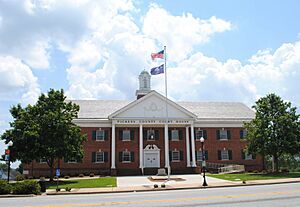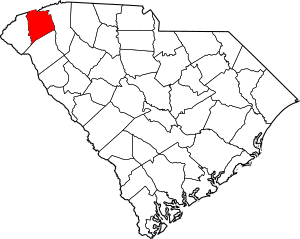Pickens County, South Carolina facts for kids
Quick facts for kids
Pickens County
|
|||
|---|---|---|---|

Pickens County Courthouse
|
|||
|
|||
| Motto(s):
"Adventure Starts Here"
|
|||

Location within the U.S. state of South Carolina
|
|||
 South Carolina's location within the U.S. |
|||
| Country | |||
| State | |||
| Founded | 1826 | ||
| Named for | Andrew Pickens | ||
| Seat | Pickens | ||
| Largest community | Easley | ||
| Area | |||
| • Total | 512.75 sq mi (1,328.0 km2) | ||
| • Land | 496.94 sq mi (1,287.1 km2) | ||
| • Water | 15.81 sq mi (40.9 km2) 3.67% | ||
| Population
(2020)
|
|||
| • Total | 131,404 | ||
| • Estimate
(2023)
|
135,495 | ||
| • Density | 264.43/sq mi (102.10/km2) | ||
| Time zone | UTC−5 (Eastern) | ||
| • Summer (DST) | UTC−4 (EDT) | ||
| Congressional district | 3rd | ||
Pickens County is a county located in the northwest part of the U.S. state of South Carolina. As of the 2020 census, its population was 131,404. Its county seat is Pickens. The county was created in 1826. It is part of the Greenville-Anderson-Greer, SC Metropolitan Statistical Area.
History
Pickens County was part of Cherokee homeland territory until well after the American Revolution. The Cherokee had allied with the British, hoping to gain expulsion of European-American settlers from their lands. But they were defeated in local battles of the Revolution and forced to cede their lands under various treaties.
This former Cherokee territory was included in the new state's Ninety-Six Judicial District. In 1791 the state legislature established Washington District, a judicial area composed of present-day Greenville, Anderson, Pickens, and Oconee counties (the latter was not organized until 1868); at that time it also included Pendleton County.
Streets for the county seat and courthouse town of Pickensville (near present-day Easley) were laid off. New buildings perhaps included a large wooden hotel, which served as a stagecoach stop. In 1798 Washington District was divided into Greenville and Pendleton districts. The latter included what eventually became Anderson, Oconee, and Pickens counties. After a new courthouse was erected at Pendleton to accommodate the Court of General Sessions and Common Pleas, Pickensville began to decline.
In view of the growing population and poor transportation facilities in Pendleton District, the legislature divided it into counties in 1826. But a year later, it decided to establish judicial districts instead. The legislation went into effect in 1828. The lower part became Anderson and the upper Pickens, named in honor of Brigadier General Andrew Pickens of the American Revolution. His home, Hopewell, was on the southern border of the district. A courthouse was established on the west bank of the Keowee River, and a small town called Pickens Court House soon developed here. Since 1825, John C. Calhoun made his home in what became Pickens County, at Fort Hill, which became the basis around which Clemson University would later grow up.
By 1860 Pickens District had a population of more than 19,000 persons, of whom 22 percent were enslaved African Americans. The district was largely rural and agricultural, with cotton the most important commodity crop. Its small industry consisted mainly of sawmills, gristmills, and a few other shops producing goods for home consumption. The district's Protestant churches were numerous, but schools were few. The Blue Ridge Railroad reached the district in September 1860. There was little organized troop combat here during the Civil War, but the district was frequently plundered by marauders and deserters who swept down from the mountains.
Post-Civil War to present
After the war, the region was largely destitute. The South Carolina Constitutional Convention of 1868, meeting during the first year of Congressional Reconstruction, changed the name "district" to "county" throughout the state. The convention also organized Oconee County, from a portion of Pickens District that was west of the Keowee and Seneca rivers, plus a small area around the Fort Hill estate formerly belonging to statesman John C. Calhoun. In the 1960s, this small area around the Calhoun property was transferred to Pickens County.
A new courthouse for Pickens County was erected at its present location. Many of the residents of Old Pickens, on the Keowee River, moved to the newly created town, some relocating their dismantled homes. The loss of the Oconee area greatly reduced the population of Pickens County. It did not again reach 19,000 until 1900.
The county's growth was accelerated by the building of the Atlanta and Charlotte Air Line Railway (later called the Southern Railway) in the 1870s. The town of Easley, named for General W. K. Easley, was chartered in 1874. The towns of Liberty and Central sprang up along the railroad about the same time and were soon incorporated. Calhoun (now part of Clemson) was founded in the 1890s, to be followed in the early 1900s by Six Mile and Norris as incorporated areas.
A major factor in Pickens County's growth was the development of the regional textile industry, which had earlier been based in New England and New York. The county's first modern cotton mill, organized by D. K. Norris and others, was established at Cateechee in 1895. By 1900 the county boasted three cotton mills, two railroads, three banks, three roller mills, 37 sawmills, ten shingle mills, and four brickyards.
Yet until 1940, with a population of 37,000 (13.2 percent black), the county remained primarily rural and agricultural. Like many other Piedmont counties, Pickens had a one-crop economy. Its citizens were engaged mainly in growing cotton or manufacturing it into cloth. A notable change in the Pickens landscape was the coming of paved highways; one completed across the county, about 1930, ran from Greenville to Walhalla by way of Easley, Liberty, and Central.
The most significant developments in the county's history have occurred since World War II. By 1972 there were 99 manufacturing plants in the county, employing almost 15,000 personnel and producing not only textiles but a wide variety of other products. The population today is estimated to be 93,894 residents. According to an article written for Pickens County Heritage, new residents continue to be attracted to Pickens County "because of its climate, industrial opportunity, proximity to Greenville's labor market, and scenic beauty".
Geography
According to the U.S. Census Bureau, the county has a total area of 512.75 square miles (1,328.0 km2), of which 496.94 square miles (1,287.1 km2) is land and 15.81 square miles (40.9 km2) (3.67%) is water. The county also contains the highest natural point in South Carolina, Sassafras Mountain, with an elevation of 3,560 feet (1,090 m). Table Rock State Park is in Pickens County.
Pickens County is in the Savannah River basin, the Saluda River basin, and the French Broad River basin.
State and local protected areas/sites
- Cateechee Point County Park
- Causey Tract, Gravely Wildlife Management Area, Clemson University
- Eastatoe Creek Heritage Preserve/Wildlife Management Area
- Glassy Mountain Heritage Preserve
- Hagood Mill Historic Site
- Jocassee Gorges Wilderness Area
- Keowee-Toxaway State Park
- Keowee Wildlife Management Area
- Laurel Fork Heritage Preserve/Wildlife Management Area
- Long Shoals Roadside Park
- Meadow Falls
- Nine Times Forest
- Nine Times Preserve
- Pinnacle Mountain
- Poe Creek State Forest (part)
- Table Rock State Park
- Twelve Mile Recreation Area
- Wadakoe Mountain Heritage Preserve/Wildlife Management Area
Major water bodies
- Lake Hartwell
- Lake Jocassee
- Lake Keowee
- Keowee River
- South Saluda River
- Table Rock Reservoir
Adjacent counties
- Transylvania County, North Carolina – north
- Greenville County – east
- Anderson County – south
- Oconee County – west
Major highways
 US 76
US 76 US 123
US 123

 US 123 Conn.
US 123 Conn. US 178
US 178 SC 8
SC 8


 SC 8 Conn.
SC 8 Conn. SC 11
SC 11 SC 28
SC 28


 SC 28 Bus.
SC 28 Bus. SC 88
SC 88 SC 93
SC 93 SC 124
SC 124 SC 133
SC 133 SC 135
SC 135 SC 137
SC 137 SC 153
SC 153 SC 183
SC 183 SC 186
SC 186 SC 288
SC 288
Major infrastructure
- Clemson Station
- Greenville-Pickens Speedway
- Pickens County Airport
Demographics
| Historical population | |||
|---|---|---|---|
| Census | Pop. | %± | |
| 1830 | 14,473 | — | |
| 1840 | 14,356 | −0.8% | |
| 1850 | 16,904 | 17.7% | |
| 1860 | 19,639 | 16.2% | |
| 1870 | 10,269 | −47.7% | |
| 1880 | 14,389 | 40.1% | |
| 1890 | 16,389 | 13.9% | |
| 1900 | 19,375 | 18.2% | |
| 1910 | 25,422 | 31.2% | |
| 1920 | 28,329 | 11.4% | |
| 1930 | 33,709 | 19.0% | |
| 1940 | 37,111 | 10.1% | |
| 1950 | 40,058 | 7.9% | |
| 1960 | 46,030 | 14.9% | |
| 1970 | 58,956 | 28.1% | |
| 1980 | 79,292 | 34.5% | |
| 1990 | 93,894 | 18.4% | |
| 2000 | 110,757 | 18.0% | |
| 2010 | 119,224 | 7.6% | |
| 2020 | 131,404 | 10.2% | |
| 2023 (est.) | 135,495 | 13.6% | |
| U.S. Decennial Census 1790–1960 1900–1990 1990–2000 2010 2020 |
|||
2020 census
| Race | Num. | Perc. |
|---|---|---|
| White (non-Hispanic) | 107,247 | 81.62% |
| Black or African American (non-Hispanic) | 8,421 | 6.41% |
| Native American | 304 | 0.23% |
| Asian | 2,723 | 2.07% |
| Pacific Islander | 37 | 0.03% |
| Other/Mixed | 6,100 | 4.64% |
| Hispanic or Latino | 6,572 | 5.0% |
As of the 2020 census, there were 131,404 people, 48,203 households, and 31,630 families residing in the county.
2010 census
At the 2010 census, there were 119,224 people, 45,228 households, and 29,540 families residing in the county. The population density was 240.2 inhabitants per square mile (92.7/km2). There were 51,244 housing units at an average density of 103.2 per square mile (39.8/km2). The racial makeup of the county was 88.7% white, 6.6% black or African American, 1.6% Asian, 0.2% American Indian, 1.4% from other races, and 1.5% from two or more races. Those of Hispanic or Latino origin made up 3.1% of the population. In terms of ancestry,
Of the 45,228 households, 30.0% had children under the age of 18 living with them, 50.0% were married couples living together, 10.8% had a female householder with no husband present, 34.7% were non-families, and 25.2% of all households were made up of individuals. The average household size was 2.48 and the average family size was 2.95. The median age was 34.9 years.
The median income for a household in the county was $41,898 and the median income for a family was $53,911. Males had a median income of $41,615 versus $31,464 for females. The per capita income for the county was $20,647. About 8.9% of families and 16.6% of the population were below the poverty line, including 18.3% of those under age 18 and 7.8% of those age 65 or over.
Economy
In 2022, the GDP was $5 billion (about $37,089 per capita), and the real GDP was $4.2 billion (about $30,795 per capita) in chained 2017 dollars.
As of April 2024[update], some of the largest employers in the county include Aramark, the city of Clemson, Clemson University, Danfoss, Ingles, Lowe's, Merck & Co., Prisma Health, Publix, St. Jude Medical, and Walmart.
| Industry | Employment Counts | Employment Percentage (%) | Average Annual Wage ($) |
|---|---|---|---|
| Accommodation and Food Services | 5,848 | 15.2 | 19,292 |
| Administrative and Support and Waste Management and Remediation Services | 971 | 2.5 | 39,572 |
| Agriculture, Forestry, Fishing and Hunting | 71 | 0.2 | 35,100 |
| Arts, Entertainment, and Recreation | 1,186 | 3.1 | 21,788 |
| Construction | 1,377 | 3.6 | 51,740 |
| Educational Services | 8,192 | 21.4 | 73,424 |
| Finance and Insurance | 575 | 1.5 | 67,340 |
| Health Care and Social Assistance | 3,679 | 9.6 | 56,056 |
| Information | 179 | 0.5 | 124,228 |
| Management of Companies and Enterprises | 53 | 0.1 | 81,484 |
| Manufacturing | 5,183 | 13.5 | 67,704 |
| Other Services (except Public Administration) | 916 | 2.4 | 36,452 |
| Professional, Scientific, and Technical Services | 1,025 | 2.7 | 75,764 |
| Public Administration | 1,771 | 4.6 | 44,772 |
| Real Estate and Rental and Leasing | 356 | 0.9 | 41,184 |
| Retail Trade | 5,769 | 15.0 | 32,136 |
| Transportation and Warehousing | 315 | 0.8 | 63,024 |
| Utilities | 401 | 1.0 | 84,656 |
| Wholesale Trade | 499 | 1.3 | 66,352 |
| Total | 38,366 | 100.0% | 50,879 |
Education
School districts
Pickens County School District is the sole school district of the county.
In 2010 the district was ranked the highest in the state with an "A−" transparency score from Sunshine Review.
Schools
- Ambler Elementary – Pickens
- Central Elementary – Central
- Chastain Road Elementary – Liberty
- Clemson Elementary – Clemson
- Crosswell Elementary – Easley
- Dacusville Elementary – Dacusville
- East End Elementary – Easley
- Forest Acres Elementary – Easley
- Hagood Elementary – Pickens
- Liberty Elementary – Liberty
- McKissick Elementary – Easley
- Pickens Elementary – Pickens
- Six Mile Elementary – Six Mile
- West End Elementary – Easley
- Dacusville Middle – Dacusville
- Liberty Middle – Liberty
- Pickens Middle – Pickens
- R.C. Edwards Middle – Central
- R.H. Gettys Middle – Easley
- D.W. Daniel High – Central
- Easley High School – Easley
- Liberty High – Liberty
- Pickens High School – Pickens
Colleges and universities
- Clemson University
- Southern Wesleyan University
Public library
Pickens County is served by the Pickens County Library System, headquartered in Easley, with four branch libraries in the county.
Communities
Cities
- Clemson (partly in Anderson County)
- Easley (largest community; partly in Anderson County)
- Liberty
- Pickens (county seat)
Towns
Census-designated places
- Arial
- Cateechee
- Clemson University
- Dacusville
Unincorporated communities
- Nine Times
- Pumpkintown
- Rocky Bottom
- Sunset
Notable people
- Bobby Baker, scandal-plagued Secretary to the Majority Leader of the Senate until 1963
- Charles H. Barker, awarded a Medal of Honor for his actions in the Korean War
- Benjy Bronk, in-studio joke writer and on-air persona for the Howard Stern Show
- John C. Calhoun, influential politician of the first half of the nineteenth century
- DeAndre Hopkins, wide receiver for the Arizona Cardinals of the NFL
- Shoeless Joe Jackson, baseball player, born July 16, 1888; closely associated with the Black Sox Scandal in 1919
- Stanley Morgan, former NFL wide receiver who played for the New England Patriots; was born in Easley on February 17, 1955; member of the New England Patriots Hall of Fame
- Ray Robinson Williams, blind lawyer and state senator
- Sam Wyche, former NFL football player and coach, resident
See also
 In Spanish: Condado de Pickens (Carolina del Sur) para niños
In Spanish: Condado de Pickens (Carolina del Sur) para niños




